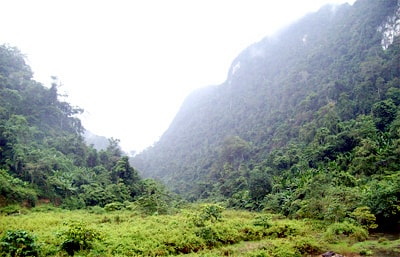Tra Lan Citadel
(Baonghean) - Standing on the right bank of Lam River, in Chi Khe Commune, Con Cuong District, looking to the other side, visitors can freely admire the scenery of Dao Nguyen Cave, stretching out in a vast blue color, with clouds and sky. This forest was once the place where Phung Khac Khoan (Trang Bung of the Later Le Dynasty) was exiled. In this place of "Mountains and waters", who would have thought that the mandarin would write a great collection of poems "Dao Nguyen Hanh".
 |
| A Tra Lan area. |
Tra Lan citadel was built on a 168m high mountain on the North bank of Lam river. This mountain is called Pu Thanh or Pu Don (pu means mountain), now belongs to Bong Khe commune, Con Cuong district. The citadel was built according to the shape of the mountain, with a circumference of about 2km. The remaining relic in the East is a moat about 600m long, about 1m - 1.2m wide. Outside the moat is a layer of bamboo fence covering the North, East - South sides, some places are 3m thick, some places the bamboo grows into a forest 20m thick.
Tra Lan Citadel was both a capital and an important military base of the occupying army in Northwest Nghe An. It blocked two important waterways and roads at that time: the "upper road" from North to South and the waterway along Lam River from Nghe An Citadel to the West.
With Tra Lan citadel, the occupying army controlled the entire forest and mountains of Western Nghe An, controlling the resistance movement of the people in the area. After many battles defeating the enemy in Bo Dang, Trinh Son, and Cam Bang, Le Loi decided to attack Tra Lan. This was the first siege of the Lam Son insurgent army. The insurgent army command closely combined military attacks with sieges to lure surrender and "strike at the hearts of the people".
In October 1424, the insurgents began to besiege Tra Lan citadel. Two months later, the enemy's situation became increasingly dire, food supplies were running out, soldiers' morale was extremely low, some tried to surrender. And so the final siege was a victory "Tra Lan region, bamboo split, ash flew".
Tra Lan citadel has undergone nearly 600 years of changes and changes. The shape of the stream and the mountains have changed a lot, but the traces are still there. Although there is no place where bamboo grows into thick forests, instead there are forests of meters, palm trees, and immense green tea. Tra Lan citadel relic is a highlight on the current tourist itinerary of Western Nghe An.
TB(Synthetic)


